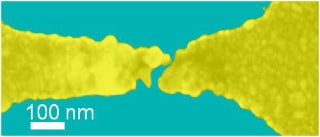Anyone who has ever used a television, radio or mobile phone knows what the role of the antenna is: it captures the signals carried in the air, the ones that make these devices so useful. A research group from Rice University has developed an antenna that captures light in the same way, on a tiny scale and with great potential.

Condensed state physicist Doug Natelson found a way to make an optical antenna consisting of two gold tips separated by a nanometer gap that receives light from a laser. The prongs "capture the light and concentrate it in a tiny space between them," said the lead researcher, which leads to a thousand-fold increase in the light intensity present in the space. The research findings were published in the scientific journal Nature Nanotechnology.
The researcher anticipates that the discovery will be useful in the development of tools for the field of optics and for the development of chemical and biological sensors, even at the level of a single particle, and will advance applications for industrial safety, defense and homeland security.
The article, written by researchers from Germany and Spain, describes the method, in which a laser beam is aimed at the gap between a pair of gold tips that are less than one nanometer apart.
"You can ignore the fact that your car antenna is made up of atoms; It just works," emphasizes researcher Natelson, a professor of physics and astronomy at Rice University. "However, when you place tiny pieces of metal very close to each other, you have to consider all the factors. The fields are supposed to be large, the situation can become complex and you may find yourself in restrictive conditions. In order to understand what exactly is happening in our device, we had to use physics that only comes into play in a situation where objects are located very close to each other."
It turned out that the key to measuring light amplification is the measurement of something completely different - the electric current passing between the gold tips. Placing nano-tips so close allows the electric charge to flow through a mechanism of quantum tunneling when the electrons "jump" from one side to the other. The researchers were able to move electrons in a very measurable and controlled manner by "pushing" them at low frequencies by applying voltage. They also managed to make them flow by projecting a laser beam, which pushes the charge through the very high frequency of the laser.
By comparing the two processes it is possible to obtain a standard value based on which the degree of light amplification can be quantified, explains the researcher. The German and Spanish partners in writing the article assisted in providing the theoretical models required for the calculations.
The amplification occurs as a result of a plasmonic effect, explains the researcher. Plasmons, which can be excited by light, are oscillating electrons found inside metallic structures and behave like waves in a closed pool. "You have a metallic structure, you shine light on it and the light causes the metallic structure to move," the researcher points out. "The electrons in the metal can be thought of as an incompressible liquid, similar to the water in a bath. And when you "shake" them back and forth, you get electric fields."
"On the surface of the metal, these fields may be very large - even more than those originating from the external radiation," the researcher points out. "What was challenging to measure was exactly this value - how big is the electric field created. Through simultaneous measurements, both of the electrical current received at a low frequency and of the optical current received at a high frequency between the two tips, this value is determined.

2 תגובות
Is there a practical example of using this invention, or will it be used as a component for larger systems
in brief. Something reminiscent of how a transistor works